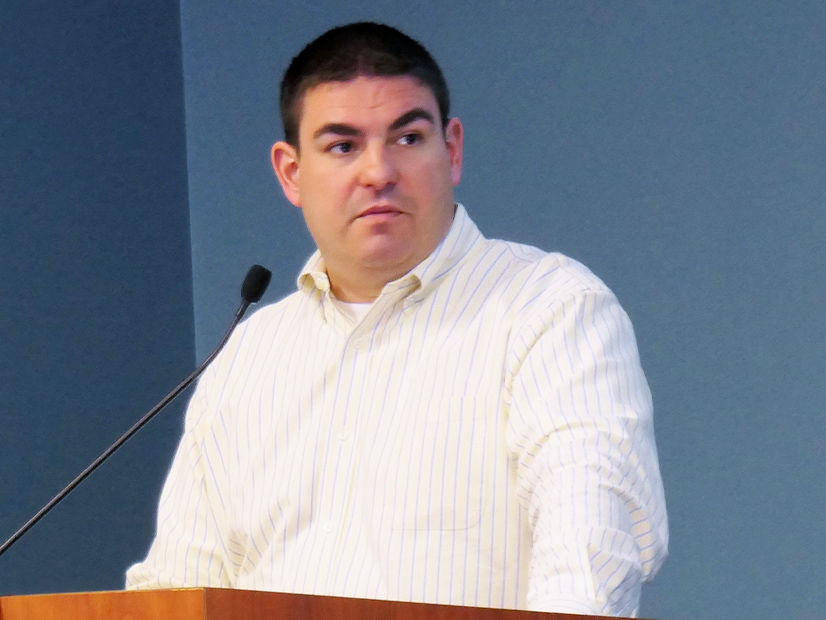CARMEL, Ind.— MISO last week released details about how it will allocate costs for its portion of the $1 billion Joint Targeted Interconnection Queue (JTIQ) portfolio of 345-kV projects with SPP.
The grid operator plans to recover a 90-10 split from incoming generation and load, respectively, for their cost share of the JTIQ portfolio through a monthly charge. MISO said it and SPP’s generation developers will make fixed payments that reduce the select transmission pricing zones’ revenue requirements over 20 years.
During a Planning Advisory Committee (PAC) meeting Wednesday, MISO counsel Chris Supino said the RTOs will use a subscription model for JTIQ planning cycles. When 125% of the portfolio’s megawatts are spoken for, it will be considered fully funded.
Should the grid operators come up short on new megawatts before all JTIQ projects are in-service, load will temporarily pay for the unclaimed megawatts. Generation projects that queue up will repay load later.
MISO staff said they are still outlining the process of what happens when a JTIQ portfolio doesn’t have enough willing takers of transmission capacity through new generation in the queue. However, Supino said it’s unlikely that the portfolios won’t be fully subscribed and funded, as they’re planned to support the evolving resource mix.
Supino said MISO is considering adding a new JTIQ participation agreement to its generator interconnection agreements that would bind parties to the cost schedules’ terms.
Potential federal funding might complicate the process. The Department of Energy in early March said the RTOs and two member entities can apply for full funding under its Grid Resilience and Innovation Partnerships (GRIP) program. (See DOE Clears JTIQ Projects to Proceed with Funding App.)
Clean Grid Alliance’s Beth Soholt asked how payments might be modified should the DOE award funding to the portfolio.
“That’s a great question, but we can’t assume we’ll have a pot of money until we actually get that money,” Supino said.
Supino said staff plans to mention the DOE application when memorializing the JTIQ study and payment process in its joint operating agreement with SPP. The RTOs plan to file with FERC as early as July.
Supino said he doesn’t yet know how DOE funding will affect repayments or reimbursements.

During a Tuesday cost-allocation working group meeting, Mississippi PSC consultant Bill Booth asked MISO to provide more details around the payments’ “timing and flow.” He said he wanted to know whether cost assignments to load will be capped and how they would be tracked in the case of temporary overpayment.
Sustainable FERC Project’s Natalie McIntire said that analyses indicate load will receive 20% on the JTIQ projects’ benefits, but only shoulder 10% of the cost.
Stakeholders asked during the PAC meeting whether staff will begin a JTIQ portfolio for the MISO-PJM seam.
Dave Johnston, an Indiana Utility Regulatory Commission staffer, said he thought it was premature to ponder a MISO-PJM JTIQ portfolio when the MISO-SPP’s process is untested and cannot be deemed a success yet.
MISO’s Andy Witmeier said in March that it’s more cost-effective for comprehensive seams planning to replace the RTO’s “back-and-forth, across the fence” affected system study process with SPP that identities expensive network upgrades.
“A lot of time those solutions are too costly for those set of projects to take on,” Witmeier said. He said it’s appropriate that most JTIQ projects’ costs be allocated to generation because they are designed to facilitate new resources.
“They’re not being built to fix market-to-market congestion or increase transfer capability, he said. “There might be tertiary benefits.”
“This is all new and novel, and if we want this to work, we’re going to have to accept some level of risk,” SPP’s David Kelley said. “I truly believe this is going to be successful and our new way of planning.”
That risk could be reduced considerably if the JTIQ portfolio wins up to a 50% share of funding through the GRIP program.
The Minnesota Department of Commerce is leading the DOE application, due May 17, with help from the Great Plains Institute. The Institute’s Matt Prorok said during April’s Organization of MISO States board meeting that the parties have a “compelling case.”
If the federal dollars are approved, the awards will be granted to RTOs and transmission developers. Prorok said parties must negotiate any awarded grant.
Prorok said the DOE application shouldn’t interfere with the RTOs’ cost-allocation discussions with their stakeholders.
“If the DOE can help us out with funding, I think those [cost-allocation] discussions will go very smoothly,” Kansas Corporation Commissioner Andrew French said during the Gulf Coast Power Association’s MISO-SPP conference in March.
“I hope JTIQ can move forward, and we can use it as proof of concept,” he said.
Aubrey Johnson, MISO’s vice president of system planning, has said DOE funding would provide certainty to members and make interconnections more attractive for developers.
During MISO’s Board Week in March, Johnson said more needs to be done to figure out how DOE funds will intermingle with cost allocation. He joked that the process won’t be as simple as the DOE “cutting a $500 million check, as much as I ask them to.”



